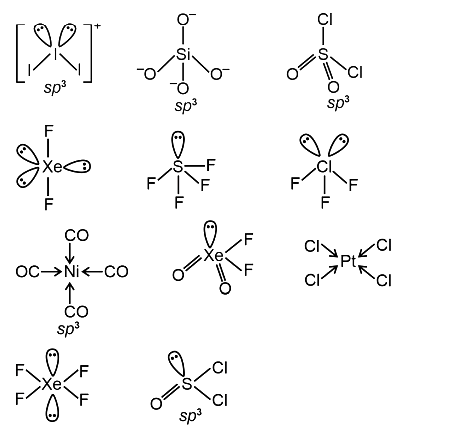Among [I3] + , [SiO4]4-, SO2Cl2, XeF2, SF4, ClF3, Ni(CO)4, XeO2F2, [PtCl4] 2−, XeF4, and SOCl2, the total number of species having sp3 hybridised central atom is ______.
Among [I3] + , [SiO4]4-, SO2Cl2, XeF2, SF4, ClF3, Ni(CO)4, XeO2F2, [PtCl4] 2−, XeF4, and SOCl2, the total number of species having sp3 hybridised central atom is ______.
Solution and Explanation
There are 5 species in total where the central atom is hybridized in the sp3 configuration.

Top Questions on Redox reactions
- At room temperature, disproportionation of an aqueous solution of in situ generated nitrous acid (HNO2) gives the species
- JEE Advanced - 2024
- Chemistry
- Redox reactions
- How many of the following show disproportionation reactions?
H2O2 , Ag, Cu- , K+ , F2 , Cl2 , ClO3-- JEE Main - 2024
- Chemistry
- Redox reactions
- \(aMnO^{-}_4+bS_2O_{3}^-+H_2O\rightarrow xMnO_2+ySO_{4}^-+zOH^-\)
a and y respectively are- KCET - 2023
- Chemistry
- Redox reactions
The equivalent weight of KIO3 in the given reaction is (M=molecular mass) :
2Cr(OH)3 + 4OH + KIO3 → 2CrO42- + 5H2O +KI- WBJEE - 2023
- Chemistry
- Redox reactions
Oxidation number of Mo in Ammonophosphomolybdate
- JEE Main - 2023
- Chemistry
- Redox reactions
Questions Asked in JEE Advanced exam
- A region in the form of an equilateral triangle (in x-y plane) of height L has a uniform magnetic field 𝐵⃗ pointing in the +z-direction. A conducting loop PQR, in the form of an equilateral triangle of the same height 𝐿, is placed in the x-y plane with its vertex P at x = 0 in the orientation shown in the figure. At 𝑡 = 0, the loop starts entering the region of the magnetic field with a uniform velocity 𝑣 along the +x-direction. The plane of the loop and its orientation remain unchanged throughout its motion.

Which of the following graph best depicts the variation of the induced emf (E) in the loop as a function of the distance (𝑥) starting from 𝑥 = 0? - Two beads, each with charge q and mass m, are on a horizontal, frictionless, non-conducting, circular hoop of radius R. One of the beads is glued to the hoop at some point, while the other one performs small oscillations about its equilibrium position along the hoop. The square of the angular frequency of the small oscillations is given by [ \(\epsilon_0 \)is the permittivity of free space.]
- JEE Advanced - 2024
- Moving charges and magnetism
- A group of 9 students, s1, s2,…., s9, is to be divided to form three teams X, Y and Z of sizes 2, 3, and 4, respectively. Suppose that s1 cannot be selected for the team X and s2 cannot be selected for the team Y. Then the number of ways to form such teams, is _______.
- JEE Advanced - 2024
- Combinations
- Let \(\vec{p}=2\hat{i}+\hat{j}+3\hat{k}\) and \(\vec{q}=\hat{i}-\hat{j}+\hat{k}\). If for some real numbers α, β and γ we have
\(15\hat{i}+10\hat{j}+6\hat{k}=α(2\vec{p}+\vec{q})+β(\vec{p}-2\vec{q})+γ(\vec{p}\times\vec{q})\),
then the value of γ is ________.- JEE Advanced - 2024
- Vector Algebra
- Let X be a random variable, and let P(X = x) denote the probability that X takes the value x. Suppose that the points (x, P(X = x)), x = 0,1,2,3,4, lie on a fixed straight line in the xy -plane, and P(X = x) = 0 for all x ∈ R - {0,1,2,3,4}. If the mean of X is \(\frac{5}{2}\) , and the variance of X is α, then the value of 24α is ______.
- JEE Advanced - 2024
- Probability
Concepts Used:
Redox Reactions
Redox Reaction:
Redox reactions are chemical reactions where oxidation and reduction take place simultaneously. In this type of reaction, there is a gain of electrons for one chemical species while the other loses electrons or simply involves transfer of electrons. The species that loses electrons is oxidized while the one that gains electrons is reduced.
Types of Redox Reactions:
Redox reactions can be differentiated into 4 categories namely combination reactions, decomposition reactions, displacement reactions, and disproportionation reactions. Each is explained separately below:
Combination Reaction:
In this, the molecules combine to form new compounds. For example, when magnesium reacts to nitrogen.
Decomposition Reaction:
Opposite to the combination reaction, here there is a breakdown of compounds to simpler substances. For example, electrolysis of water.
Displacement Reaction:
In this, the more reactive metal will displace the less reactive one in a chemical reaction. The reactivity of an element is represented in a series called the reactivity series (arranged in decreasing order of reactivity) which makes it easier to determine the chemical reaction and its products.
Disproportionation Reaction:
This is a peculiar type of reaction where an element showing a particular oxidation state will be oxidized and reduced simultaneously. Another thing to note is that these reactions will always have an element that can exhibit three oxidation states.



